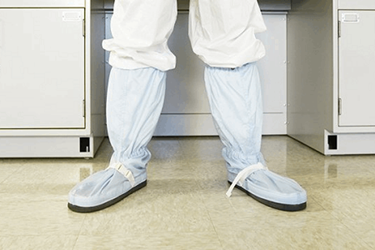Best Practices For Keeping Human Error Out Of The Cleanroom
By Danielle DeLucy, ASA Training & Quality Consulting, LLC

Contamination control activities aim to permanently ensure a sufficient level of cleanliness in controlled environments. This is accomplished by maintaining, reducing, or eradicating viable and non-viable contamination for sanitary purposes or to maintain an efficient rate of production.
Cleanroom contamination is a common problem faced by many aseptic manufacturers and has many causes. Unfortunately, the most common root cause is the operators working inside these cleanrooms. Human performance deviations or failures in the cleanroom are linked to many variables:
- Complex aseptic processing tasks
- The continuous span of time during which an operator carries out repetitive aseptic activities
- The expected rate of activity
- Changes in personnel
As humans, we are expected to be carriers of some unwanted microorganisms. In fact, over 200 different species of bacteria are associated with humans and are found in the intestines, eyes, nose, mouth, hair, and skin. Believe it or not, dry skin can contain thousands of microbes per square millimeter! People are not only a source of contamination, but also an agent for transferring contamination to locations that could pose a risk to the product. Microorganisms are spread by sneezing, coughing, and touching. While microorganisms suspended in the air are less of a concern, should such organisms gravitate toward a product or critical location, they may present a significant risk. Most bacteria in cleanroom air currents are not free-living but are instead the result of direct particle shedding of skin cells of the people working inside the cleanroom.
Contamination poses a significant risk to technical processes, experiments, and production activities, as well as to the individuals involved. Unguarded proliferation of contamination can quickly lead to product damage, yield reduction, and product recalls. Many businesses are not adequately protecting themselves from the harmful effects of contamination, and many products in many industries are recalled due to unsafe manufacturing processes.
There are several ways to keep human error and contamination out of the cleanroom. First, let’s talk about the most effective line of defense: proper gowning.
When selecting the proper attire to wear in the cleanroom, consider:
- Is the gown made of a non-shedding material?
- This helps keep the cleanroom free from non-viable particles that could potentially contaminate the area and the product.
- Does the apparel provide complete coverage of the operator’s exposed skin?
- The hoods, goggles, and face mask should fit snugly so no skin is exposed.
- How long will the operator be required to wear the gown, and will the gown maintain its integrity?
- Operators should only wear the gown for as long as they are in the cleanroom area. They should not re-don a gown after removing it. A new, sterile cleanroom garment needs to be donned each time the operator re-enters the area.
- Is the apparel comfortable for the operator?
- The apparel should be breathable and made of a light material. Keep in mind that if an operator becomes overheated and perspires, there is a risk of particle shedding which can negatively impact the product and environment.

Get Danielle's expert advice to keep human error out of the cleanroom in the webinar:
Understanding Aseptic Technique and Cleanroom Behavior – Avoiding Human Error
Along with these considerations, the manufacturing unit must also have a robust training and qualification program to ensure the operators have a basic understanding of microbiology principles, the proper way to handle and don a gown, and the correct way to behave in the cleanroom environment. There are cleanroom standards and guidances to set up training plans and qualifications, for example, ISO 14644-5, Cleanrooms and associated controlled environments — Part 5: Operations. Its topics include:
- operational systems that must be in place
- selection and use of appropriate cleanroom garments
- training and monitoring of personnel and activities
- installation and use of equipment
- requirements for materials used in the cleanroom
- maintaining the cleanroom environment in a clean, usable condition conforming to design standards.
Next, let’s review some additional ways to avoid deviations and human error in the cleanroom. The maximum number of personnel in clean areas during routine aseptic processing simulations should be established. The number is based on the results of environmental data, the ease of working together in the space, and the results of the product tested in the area. These variables are examined as a whole to determine how many operators can be in the cleanroom at any one time. In addition, anyone who needs access to the cleanroom must be adequately trained on gowning procedures. A formal authorization program should be established to ensure no unauthorized access to the cleanroom environment.
Human error in the cleanroom can also be attributed all the way back to the locker rooms, where operators gather prior to going into the gowning area. It is here that the operators need to ensure proper hand washing and sanitizing. The firm should have a standard operating procedure that lists their hygiene and cleanliness standards. A few things to note in this document are:
- Operators should not enter cleanrooms if ill or with open wounds.
- Operators should go through periodic health checks conducted by a workplace healthcare provider at least yearly.
- Operators should have garments that are non-shedding, and their movements should be slow and controlled while in the cleanroom.
- There should be no introduction of microbiological hazards into the area, such as bringing in workplace identification badges, non-cleanroom paper or pens, clipboards, etc.
- No outdoor clothing should be brought into clean areas; operators should be clad in factory clothing.
- Changing and washing procedures should be included.
- No watches, jewelry, and cosmetics should be worn, even if they are under the gown.
Once the operator is aware of the proper way to enter a gown room and to properly gown, it is up to them to behave in a way that does not cause contamination to themselves or the product.
- Contact sterile materials only with sterile instruments.
- Do not contact sterile products, containers, closures, or critical surfaces with any part of the gown or gloves.
- Keep the entire body out of the path of unidirectional airflow.
- Approach a necessary manipulation in a manner that does not compromise sterility of the product.
- In the unfortunate event that a sterile implement or tool falls to the ground, do not pick it up and use it. Ensure the room is stocked with additional sterile supplies.
Controlling contamination via humans and human error can be difficult. However, proper procedures can significantly reduce the number of human contamination deviations. Proper gowning and aseptic technique are important for compliance with patient safety. Maintaining a robust training and qualification program pertaining to gowning will ensure both the employees and the firm meet the established guidelines. It is important to keep an open line of communication with the cleanroom operators as well to relay both positive and negative gowning results. Their commitment to following proper protocol is essential to maintaining patient safety.
About The Author:
 Danielle DeLucy is owner of ASA Training & Quality Consulting, LLC, which provides pharmaceutical- and biologics-based companies with training and quality systems assistance in order to meet regulatory compliance. Prior to this role, she spent 15 years in the industry serving in numerous quality management roles. She has helped lead many regulatory health inspections and was instrumental in the coaching process of her peers prior to any inspection. Currently, DeLucy assists companies that are faced with warning letters or consent decrees and those wishing to improve compliance and establish more robust quality systems.
Danielle DeLucy is owner of ASA Training & Quality Consulting, LLC, which provides pharmaceutical- and biologics-based companies with training and quality systems assistance in order to meet regulatory compliance. Prior to this role, she spent 15 years in the industry serving in numerous quality management roles. She has helped lead many regulatory health inspections and was instrumental in the coaching process of her peers prior to any inspection. Currently, DeLucy assists companies that are faced with warning letters or consent decrees and those wishing to improve compliance and establish more robust quality systems.
